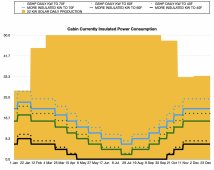AlaskanNoob
Solar Enthusiast
- Joined
- Feb 20, 2021
- Messages
- 904
Yeah I've got to have all my panels facing directly south, straight up and down (for the winter months due to snow and low sun angle). The whole reason for this massive and expensive system (at least to me) is to try to get as much of the four hours of sun we get on December 21st and translate that into electricity when it's cold outside. To operate our heat pump. Because I'm tired of the near death experience that comes with me cutting down trees and then chainsawing them up, things I do with the same amount of expertise as I have demonstrated in the realm of electricity.Oh, my bad. Is Victron 450/200 the highest voltage they offer?
Some other brands have 600V SCC. I use 600V GT inverters. there are 1000V inverters.
You don't want 250V, even lower. At least stick with 450V and calculate Voc carefully.
I think you can use 8 panels in series not 7, but double check.
Normally I tell people to make one string face SE, another SW, and connect in parallel. They don't peak at the same time, give more hours of production, so better use of SCC and wire. But in your location probably due South is the only thing to consider.
The reason we have a 500 foot run from the PV to the cabin is because the cabin is on our one gorgeous spot (ocean & mountains & glaciers but zero sun for two months out of the year) and the one spot that sees the sun year round is 500 feet away.
So here I am. Considering paying $15,000 for 32 x 500 foot wires. In the hope that I can translate four hours of sun a day into not cutting firewood.
Last edited:





